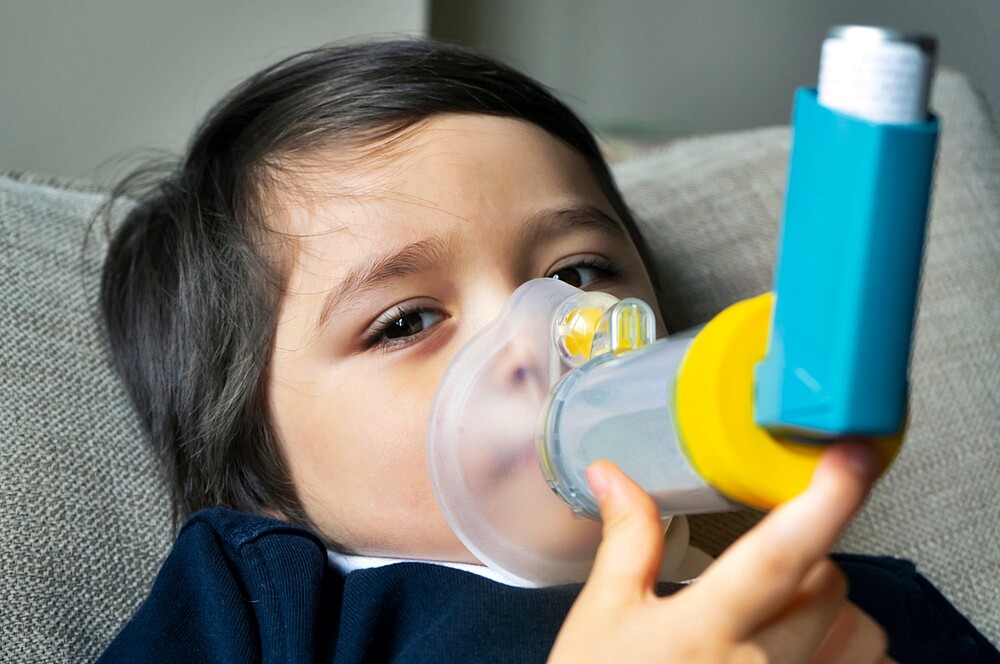Spastic bronchitis mainly affects babies and small children. Here we reveal what parents should know and how they can help their child.
What is spastic bronchitis?
Spastic bronchitis is a form of acute bronchitis that mainly affects babies and small children. The bronchi of affected children are inflamed and produce excessive amounts of mucus. As the mucous membranes of the bronchial tubes swell, they constrict, which is why it is also called obstructive (obstruction = narrowing) bronchitis. In addition, the muscles of the respiratory tract tense up, which explains the term spastic (= spasmodic) bronchitis. The disease causes symptoms such as coughing, whistling breath sounds and shortness of breath and should be treated in consultation with the paediatrician.
The bronchial tubes of children and babies are not yet fully developed, which is why they are very susceptible to this form of bronchitis. In adults, on the other hand, it hardly occurs at all. However, since the disease is caused by viruses, bronchitis is contagious.
Causes and risks of spastic bronchitis
First and foremost, the disease is caused, like almost all acute bronchitis, by viruses that are transmitted by the air we breathe, cough, sneeze or touch. In many cases this “only” causes a cold, but certain risk factors increase the risk of spastic bronchitis. These include:
- Existing lung diseases or allergies, for example allergic asthma
- Premature births, early contact with pollutants and germs of all kinds
- Smoking during pregnancy / passive smoking
- Bronchial hyperresponsiveness: This is a hypersensitivity of the bronchial tubes, which are very sensitive to irritation and infection of any kind
Symptoms: How do I recognize the bronchitis?
The following symptoms can be caused by the spastic form of bronchitis:
- Crampy cough with sputum, especially in the morning. The sputum itself is whitish in bronchitis, in severe cases bloody. If it turns yellowish or green, the so-called super-infection is likely – then bacteria have settled on the mucous membranes in addition to the viruses. If left untreated, chronic bronchitis can also develop.
- Wheezing, whistling breath sounds
- Exhaustion due to the constant coughing
- Respiratory distress (In severe cases the lips, nails and skin turn bluish, breathing is excessively rapid. Here the emergency doctor should be called).
- Other cold-like complaints such as fever, limb and headaches and sore throat
Especially due to the shortness of breath in bronchitis, children quickly become restless or nervous and even panicky. Here it is particularly important that the parents themselves remain calm and also calm the offspring – panic can further intensify the shortness of breath and the urge to cough.
The symptoms of bronchitis are also very similar to those of bronchial asthma. However, this tends to result in a dry, irritable cough, and the symptoms persist. The symptoms of spastic bronchitis, on the other hand, should have subsided significantly after one to two weeks.
Treatment: What helps against bronchitis?
In the case of bronchitis, coughing up excess mucus is most important for healing – this applies to all forms. A herbal cough expectorant can help, but there are also many home remedies for bronchitis. The following tips can also help with acute symptoms:
- Drink a lot: In order for the mucus to become liquid and to be coughed up more easily, a lot of liquid is necessary – especially water and herbal tea, for example chamomile.
- Rest: The immune system must fight against bronchitis and should not be additionally stressed. Patients should therefore take it easy, breathing is easier with a slightly raised upper body.
- Humid room air: Dry room air increases the irritation of the throat in bronchitis. Regular airing expels the pathogens from the air we breathe, moist towels over the heating keep the air pleasantly moist.
- No smoking: Tobacco smoke increases bronchitis symptoms. It is best not to smoke at all in the home.
- Cramp reliever: If the airways are crampy, the doctor can prescribe so-called sympathomimetic drugs for bronchitis, which widen the airways again. However, this does not work if the narrowed bronchial tubes are caused by a swollen mucous membrane.
- Antibiotics: Since antibiotics only work against bacteria, their use in bronchitis is only useful if the infestation with bacteria is also proven.
In case of spastic bronchitis, the chest should not be rubbed with oils or ointments – this can additionally irritate the bronchial tubes. Essential oils are also generally not suitable for children.
To the hospital with bronchitis?
In severe cases or when babies are affected, treatment of bronchitis in hospital may also be necessary. In most cases, however, the disease heals without consequences.


After years of smoking I was diagnosed of Bronchitis at 46 and COPD at 51. I had severe shortness of breath, especially after energetic activities. I was on albuteral inhaler and host of medications, nothing really helped. Few years ago, I began to do a lot of research and came across HERBAL HEALTHPOINT (w w w. herbalhealthpoint. c o m) and their COPD HERBAL TREATMENT. After seeing positive reviews I quickly started on the treatment, i experienced significant reduction/decline in major symptoms, including the shortness of breath. Its been over 2 years since treatment, i live symptom free